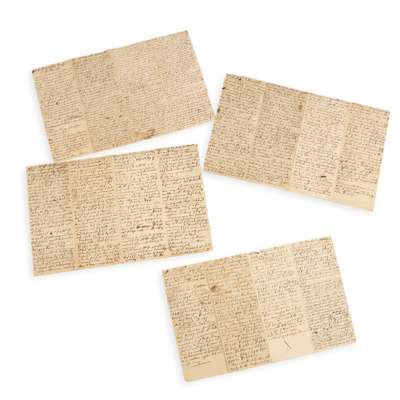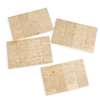
Lot 34

"The Douglas Cause" - a collection of legal case notes attributed to Lord Eliock
Beginning 16th July 1766


Auction: 18 June 2025 from 10:00 BST
Description
Four leaves, each 31 x 20cm, folded into four sections to make 8 ‘pages’ per leaf, handwritten with case notes regarding “The Douglas Cause”, including notes regarding case law: “Cases of this Sort in other countries - ? Bopius p.259 de part ? where the birth of a child produced by Elintherius Rusea? and his wife was tried and decided - in this case it appeared that there could be no direct proof…”, discussing possible proofs of pregnancy and witness statements relating to morning sickness etc., discussing evidence and proof: “As to the Enlevmet. of Ma. Mignon, for ye. is proof of her selling her child. - ? obliged to prove the Defce. Mignon's Son ? but from ohr. circumst. strong presumptions.”, and other notes
Footnote
“The Douglas Cause” was a 1760s cause célèbre and legal battle between Archibald Douglas and James Douglas-Hamilton. Archibald Douglas, the first Duke of Douglas, was quiet, reclusive and, it is theorised, experienced severe struggles with mental health. He was not expected to marry and produce an heir, and it was assumed his sister, Lady Jane Douglas, would inherit. If both siblings remained childless, the Dukes of Hamilton, Douglas kinsmen, would inherit the Douglas fortune and titles.
In 1746, aged 48, Lady Jane Douglas married Colonel John Stewart in secret, assumed the surname Gray and travelled to the Continent. However, aged 50, Lady Jane suddenly admitted to the marriage and announced the birth of twin sons, Archibald and Sholto. The Duke Archibald Douglas - with the unexpected support of the Hamiltons - refused to recognise his new nephews as his heirs. Returning to Britain in 1751 in poverty, Stewart was imprisoned. Lady Jane and Sholto sadly died in 1753, and the young Archibald was left in the care of his kinsman Charles Douglas, 3rd Duke of Queensberry. Archibald Stewart's fortunes improved slightly in 1761 when his uncle finally recognised him as his heir and settled his estates upon the boy, ten days before he died. The Dukedom expired with the Duke, however, the Marquessate of Douglas passed to the child James Douglas-Hamilton. Nonetheless, Archibald Stewart inherited the Duke's properties and inheritance of £12,000 a year, changing his name to Archibald Douglas, after his uncle.
The Hamiltons contested the inheritance, claiming that Archibald was the kidnapped or sold child of Jacques Louis Mignon, whilst his brother had been the son of ‘Sanry the Rope Dancer’. In 1762, they launched an action in the Court of Session, claiming that Archibald was not Lady Jane's son and had no claim to the inheritance. The legal notes found here date from 1766, nearing the end of the proceedings, and debate the witnesses to the twins' parenthood, Lady Jane's pregnancy and other matters. In 1767, Robert Dundas ruled in favour of the Hamiltons. However, this was appealed and the verdict, in 1769, found in favour of Douglas.
Despite what must have been a rather traumatic childhood, Archibald Douglas became one of the richest magnates in Scotland, a notable MP and father to nine children.

